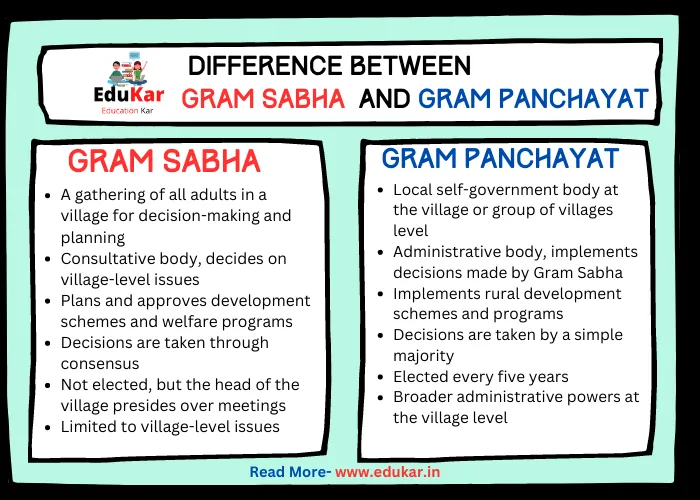When discussing local government in India, two important terms come up often: Gram Sabha and Gram Panchayat. While these two terms are related, they represent different aspects of local governance. In this article, we will define these terms and discuss the key differences between them.
What is Gram Sabha?
Gram Sabha is the village-level assembly of citizens, which includes all adults over the age of 18 who reside in the village. According to the Constitution of India, Gram Sabha is the foundation of the democratic system in rural areas. The primary aim of Gram Sabha is to empower people, especially those from marginalized or disadvantaged communities, to participate in the decision-making process on matters such as social welfare, local development, and natural resources management.
What is Gram Panchayat?
Gram Panchayat is a local self-government institution that represents the Gram Sabha in rural areas. It is the lowest tier of governance in India and plays a critical role in the implementation of rural development schemes and programs. Gram Panchayat consists of elected representatives or members who are responsible for managing and coordinating various development activities in the village.
Key Differences Between Gram Sabha and Gram Panchayat
While Gram Sabha and Gram Panchayat are interrelated, they differ in several significant ways. Here are some key differences:
1. Composition:
Gram Sabha consists of all adults over the age of 18 who reside in the village, while Gram Panchayat consists of elected representatives or members.
2. Role:
Gram Sabha is a deliberative body that provides a platform for citizens to express their views and demands, while Gram Panchayat is an executive body that is responsible for implementing and executing various development programs and schemes.
3. Powers and Functions:
Gram Sabha has certain powers and functions such as electing members of Gram Panchayat, approving development plans, and monitoring the implementation of various government programs. In contrast, Gram Panchayat has more powers and functions such as preparing and implementing local development plans, issuing licenses, and maintaining records of births, deaths, and marriages.
In conclusion, Gram Sabha and Gram Panchayat are two important components of local governance in rural areas of India. While they share similar objectives, they differ in their composition, role, powers, and functions. It is important to understand these differences to appreciate the significance of local democracy and its impact on rural development.
Table difference between gram sabha and gram panchayat
| Gram Sabha | Gram Panchayat |
|---|---|
| Gram Sabha is a collection of all the adult members of a village. | Gram Panchayat is a local self-government body that is elected by the people of the village. |
| It is responsible for making important decisions related to the village area. | It is responsible for the overall development of the village. |
| It is a forum for discussing and addressing the problems and issues of the village. | It has the power to implement various schemes and programs for the welfare of the village. |
| The Gram Sabha is not a permanent body and can be convened as and when required. | The Gram Panchayat is a permanent body and has a tenure of five years. |
| All the adult members of the village are the members of the Gram Sabha. | The members of the Gram Panchayat are elected representatives of the village. |

